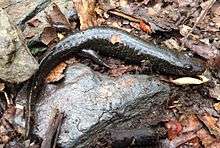Blackbelly salamander
The blackbelly salamander (Desmognathus quadramaculatus) is a species of salamander in the family Plethodontidae. It is endemic to the United States.[2] Its natural habitats are rivers, intermittent rivers, and freshwater springs. It is threatened by habitat loss.[1]
| Blackbelly salamander | |
|---|---|
 | |
| Scientific classification | |
| Kingdom: | Animalia |
| Phylum: | Chordata |
| Class: | Amphibia |
| Order: | Urodela |
| Family: | Plethodontidae |
| Subfamily: | Plethodontinae |
| Genus: | Desmognathus |
| Species: | D. quadramaculatus |
| Binomial name | |
| Desmognathus quadramaculatus (Holbrook, 1840) | |
| Synonyms | |
| |
Description
The blackbelly salamander is a medium-sized salamander growing to about 10 to 18 centimetres (3.9 to 7.1 in) long. It is sturdily built with a long tail. The ground colour is dark brown or black with two rows of small pale spots along each side of the back. The underside is usually black but may have pale flecks in young individuals.[3]
Distribution and habitat
The blackbelly salamander is found in the Appalachian Mountains in southeastern United States. Its range extends from West Virginia, through southeastern Virginia, eastern Tennessee, western North Carolina and northern Georgia. It is a largely aquatic species and lives in cold mountain streams at heights of 375 to 1,725 metres (1,230 to 5,659 ft) above sea level.[4]
Behaviour
The blackbelly salamander spends more time in water than all other members of the genus except the shovelnose salamander (Desmognathus marmoratus).[4] It mainly forages on land and has a home range of at least 1,200 square centimetres (190 square inches) but seldom travels more than 30 centimetres (12 in) from the stream.[4] In this home range it has one or more refugia, crevices in the rock or burrow entrances in which it can conceal itself, ambushing small invertebrates as they pass by. It defends these refugia against other members of its own species.[4]
Breeding takes place in the late spring. The female attaches fifteen to forty eggs to the base of submerged boulders. The eggs hatch in about three months and the larvae develop slowly, undergoing metamorphosis into juvenile salamanders about three and a half years later.[3]
Ecology
Several other species of salamander occupy the same range as the blackbelly salamander. These include the dusky salamander (Desmognathus fuscus), the Allegheny Mountain dusky salamander (Desmognathus ochrophaeus), and the seal salamander (Desmognathus monticola). Blackbelly and seal salamanders seem to actively avoid each other and it is possible that they use chemical cues to avoid coming into contact.[4] They are sometimes attacked by garter snakes (Thamnophis sp.). The blackbelly salamander's defence strategies include its warning colouration (though it is not in fact toxic), remaining still in the hope a predator will fail to notice it, biting the aggressor, and shedding its tail (autotomy) as a distraction. Biting was successful against garter snakes and was also used against shrews.[4]
Status
The IUCN Red List of Threatened Species lists the blackbelly salamander as being of "Least Concern". The reasons given are that the population seems stable with an estimated number of at least 10,000 individuals. It might decline in some localities if streams become acidic as a result of mining activities, and in some places, fishermen capture it for use as bait.[1]
References
- Hammerson, Geoffrey (2004). "Desmognathus quadramaculatus". IUCN Red List of Threatened Species. 2004. Retrieved 2012-09-25.CS1 maint: ref=harv (link)
- Frost, Darrel R. (2014). "Desmognathus quadramaculatus (Holbrook, 1840)". Amphibian Species of the World: an Online Reference. Version 6.0. American Museum of Natural History. Retrieved 1 March 2015.
- King, Matthew. "Blackbelly Salamander (Desmognathus quadramaculatus)". Savannah River Ecology Laboratory. Retrieved 2012-09-25.
- Watson, Mark B.; Pauley, Thomas K.; Camp, Carlos D. "Desmognathus quadramaculatus Holbrook, 1840". AmphibiaWeb. Retrieved 2012-09-25.
